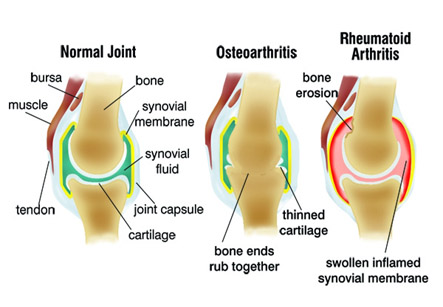Arthritis
Introduction
Arthritis means inflammation of one or more joints. A joint is the area where two bones are joined to each other which helps in movement. There are over 100 different types of arthritis.
A cartilage called as hyaline cartilage covers the opposing surfaces of the bones and provides smoothness so that the bones involved in the joint can glide easily over each other. It also protects the joint and does the shock absorbing function. In arthritis, there is the breakdown of this cartilage. This results in rubbing of bones over each other causing pain, swelling, redness and stiffness.
Causes and risk factors:
Joint inflammation may result from:
1. Fracture
2. Autoimmune diseases
Iran ranks among the top 10 countries in orthopedics and Iranian surgeons perform high quality orthopedic surgeries at highly affordable prices

3. Ageing
4. Bacterial or viral infection of joint
Sometimes the arthritis is short lived (acute) or it may persist even after the treatment of the cause (chronic).
Types of arthritis:
1. Osteoarthritis. This is the most common type.
2. Ankylosing spondylitis
3. Gouty arthritis
4. Gonococcal arthritis
5. Juvenile rheumatoid arthritis (in children)
6. Arthritis due to other bacterial infections
7. Psoriatic arthritis
8. Connective tissue disorders like scleroderma
9. Reactive arthritis (Reiter’s syndrome)
10. Rheumatoid arthritis (in adults)
11. Systemic lupus erythematosus (SLE)
Symptoms of arthritis:
1. Joint pain
2. Joint swelling
3. Reduction in range of joint motion
4. Redness of skin over a joint
5. Joint stiffness more during morning
6. Joint area is warm
Signs and tests:
The doctor or orthopedic surgeon asks the symptoms and previous medical history to diagnose the underlying cause of the arthritis.
Then, physical examination is done which can show:
1. Warm, red and tender joints
2. Fluid in and around the joint
3. Limited range of joint motion
4. Sometimes there are joint deformities which suggest chronic rheumatoid arthritis.
5. Other signs of underlying systemic disease.
Blood tests and X-rays of the affected joint are ordered. Or else, a sample of joint fluid is removed with a needle and sent for laboratory examination.
Treatment:
The aim of treatment is to reduce pain, improve joint function, and prevent further joint damage. The underlying cause cannot usually be cured. Quality of life improvement is final goal.
Lifestyle changes:
These are very crucial for treating osteoarthritis and other types of joint inflammation.
Exercise can help in relief of joint stiffness, reduces pain and fatigue, and improves muscle tone and bone strength. The best exercise program can be decided by the doctor for the patient.
The programs may include:
1. Aerobic activity or endurance exercise
2. Range of motion exercises for flexibility of joint
3. Strength exercise for muscle tone
Physical therapy:
1. Heat or ice therapy
2. Various splints to improve joint position or deformities
3. Massage
4. Water therapy
Other precautions or self-care tips:
1. Sleeping for 8 to 10 hours a night and taking naps during the day can help you recover from a flare-up faster
2. Staying in one position should be avoided
3. Avoid stressful movements
4. Necessary changes in home like fixing grab bars in shower, the tub, and near the toilet.
5. Stress-reducing activities such as meditation, yoga, or tai chi should be done.
6. Eat more fruits and vegetables rich in vitamin E and foods containing omega-3 fatty acids, such as cold water fish (salmon, mackerel, and herring), soybeans, soybean oil, pumpkin seeds, and walnuts.
7. Lose excess weight.
Medications:
Medications may be prescribed along with lifestyle changes. It is important that the patient should be closely monitored by a doctor when taking arthritis medications.
Over the counter medicines:
1. Acetaminophen is usually tried first. Do not take more than the recommended dose or take the drug along with a lot of alcohol. This can damage the liver.
2. Aspirin, ibuprofen, or naproxen are non-steroidal anti-inflammatory drugs (NSAIDs) used for relieving arthritis pain. However, their long term use has potential side effects like heart attack, stroke, ulcers of stomach, bleeding from the digestive tract, and kidney affection.
Prescription medicines:
1. Biologics- these are made by genetic recombination. They include etanercept , infliximab, adalimumab, abatacept, rituximab, golimumab, certolizumab, and tocilizumab. These drugs help improve the quality of life for many patients, but can have serious side effects.
2. Steroids- they help in reducing inflammation. They can be injected into painful joints or given orally.
3. Disease-modifying anti-rheumatic drugs (DMARDs) – these are used to treat autoimmune arthritis. They include drugs like methotrexate, gold salts, penicillamine, sulfasalazine, and hydroxychloroquine.
4. Immunosuppressants- these modulate the immune system and dampen it. They are azathioprine or cyclophosphamide.
Surgery and other treatments:
1. Arthroplasty to reconstruct the joint
2. Total joint replacement